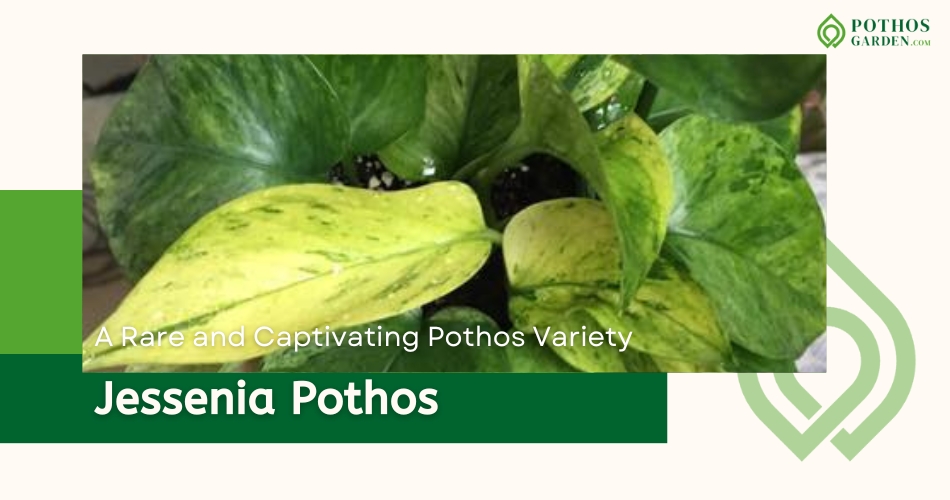Get ready to be captivated by the beauty of Jessenia pothos (Epipremnum aureum ‘Jessenia’)—a unique and scarce variety that has recently become part of the pothos family.
This extraordinary plant, originating from Costa Farms, showcases stunning marbled leaves in shades of emerald green and chartreuse. Its distinct variegation gives it a striking resemblance to the highly sought-after Golden Pothos, with the only difference being its charming chartreuse markings. With its rarity, Jessenia pothos is a true treasure that will elevate any plant collection.
What Makes Jessenia Pothos Unique
Striking Variegation
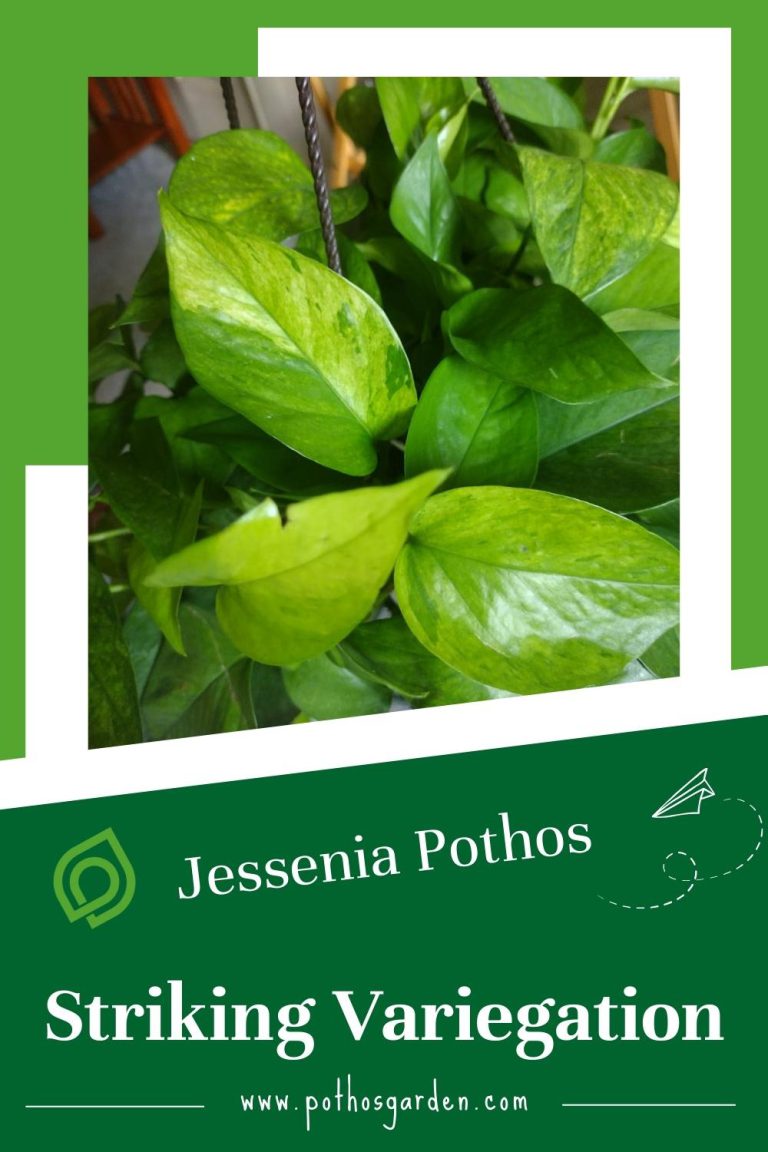
One of the standout features of Jessenia Pothos is its mesmerizing variegation. Its lush, heart-shaped leaves are adorned with splashes of vibrant green and limey yellow, creating a stunning contrast that adds visual interest to your indoor oasis.
This variegation is not only visually appealing but also helps the plant to adapt to different lighting conditions, making it an adaptable and versatile choice for your home.
Thriving in Low Light
If you’re looking for a plant that can thrive in those dimly lit corners of your home, Jessenia Pothos is an excellent choice. It has a remarkable ability to tolerate low-light conditions, making it an ideal option for spaces with limited natural light.
Whether it’s a cozy bedroom or a secluded office nook, Jessenia Pothos will bring a touch of greenery and vitality to even the darkest corners of your home.
Air Purifying Properties
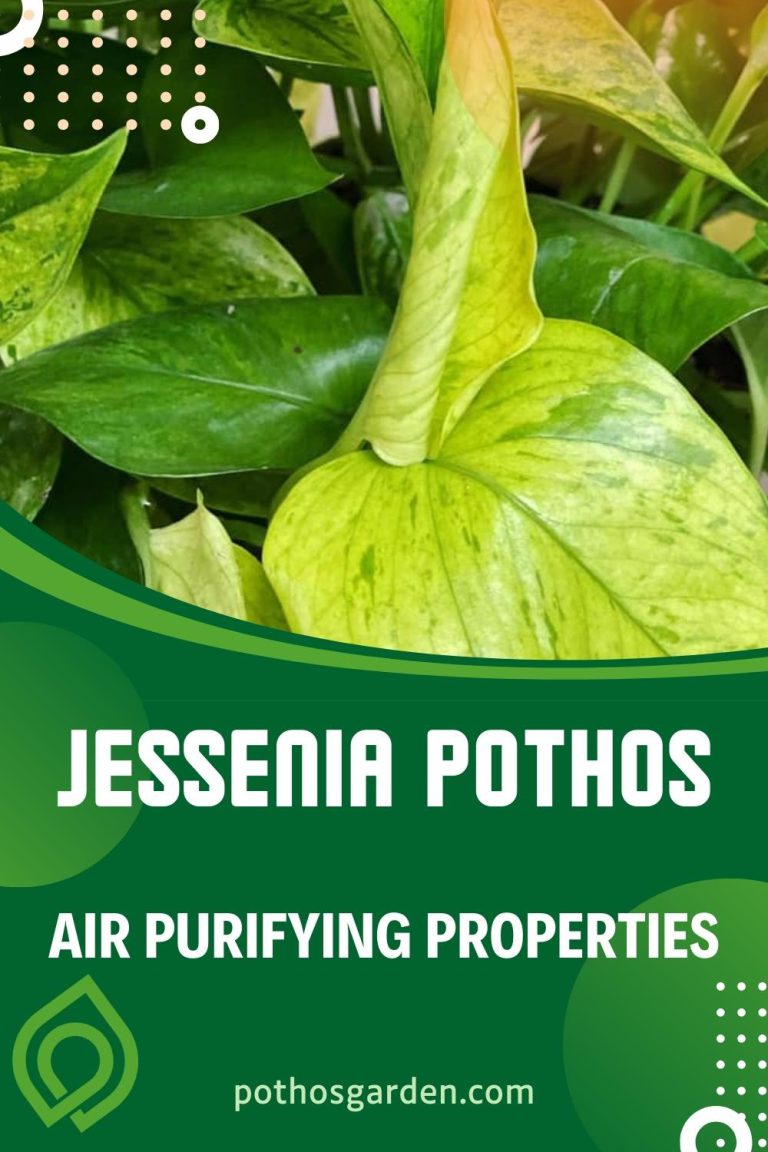
Beyond its visual appeal, Jessenia Pothos is also like its other relatives renowned for its air-purifying qualities. It has the remarkable ability to remove toxins, such as formaldehyde and benzene, from the air, creating a healthier and more breathable environment for you and your loved ones.
Easy Care and Maintenance
If you’re new to plant parenting or have a busy schedule, Jessenia Pothos is here to ease your worries. Like other varieties of Pothos, this tropical beauty is known for its resilience and low-maintenance nature.
It can adapt to a variety of environmental conditions and doesn’t require constant attention. With proper watering and occasional pruning, Jessenia Pothos will reward you with its lush foliage without demanding too much of your time or energy.
USDA Zones 10 and 11
The USDA Hardiness Zones are a system used to determine the suitability of plants based on average annual minimum temperatures. USDA Zones 10 and 11 are designated for regions with mild to warm climates.
- USDA Zone 10: This zone has an average annual minimum temperature range of 30 to 40 degrees Fahrenheit (-1 to 4 degrees Celsius). It includes areas such as southern Florida, parts of southern Texas, and coastal regions of California.
- USDA Zone 11: This zone has an average annual minimum temperature range of 40 to 50 degrees Fahrenheit (4 to 10 degrees Celsius). It includes tropical regions, such as Hawaii and the southernmost parts of Florida.
Jessenia Pothos thrives in warm and tropical climates, making USDA Zones 10 and 11 ideal for its growth. These zones offer the necessary temperature range and conditions for the plant to flourish, with mild winters and long periods of warmth and humidity.
The Aesthetics of Jessenia Pothos
Tropical Look
Its lush and vibrant foliage transports you to far-off lands, creating a serene and tropical ambiance that soothes the soul. Experience the tranquility of the tropics without leaving the comfort of your home.
Long Trailing Vines
These graceful tendrils add an element of drama and elegance to any setting, making it an ideal choice for hanging baskets or elevated shelves. Allow the vines to gracefully drape down, creating a captivating display that elevates the aesthetics of your space.
Heart-Shaped, Waxy Leaves
Its heart-shaped leaves add a touch of romance and sophistication to the plant’s overall appearance. Their glossy texture enhances their visual appeal, making Jessenia Pothos an exquisite addition to any botanical collection.
Variegated Green Leaves
Jessenia Pothos’ variegated green leaves with delicate streaks of chartreuse or light green, these leaves offer a stunning display of depth and texture. Each leaf becomes a living work of art, enhancing the visual intrigue of this remarkable plant.
Comparing Jessenia Pothos with Other Varieties
Marble Queen Pothos
Jessenia and Marble Queen Pothos, two beloved varieties of the pothos family, showcase distinct differences in their captivating foliage.
Jessenia Pothos reveals gold-green variegation against mid-green leaves, with a limey-green and darker variegation compared to Marble Queen. While Jessenia tends to grow more slowly, Marble Queen features creamy white or pale yellow variegation on moss-green leaves.
Leaf size sets them apart, with Jessenia displaying light green, heart-shaped leaves and Marble Queen exhibiting larger heart-shaped leaves. Notably, Jessenia is a newer and rare find, whereas Marble Queen is a commonly available variety.
Golden Pothos

Golden Pothos is often confused with Jessenia due to its similar green leaves. However these two captivating pothos varieties have distinctive attributes.
While Golden Pothos is commonly available, Jessenia Pothos stands as a newer and rare gem. The growth rate sets them apart, with Jessenia tending to grow more slowly than the vigorous Golden Pothos.
Leaf size showcases their unique charm, with Golden Pothos boasting heart-shaped mid-green foliage embellished in creamy gold, while Jessenia flaunts light green, heart-shaped leaves with chartreuse highlights.
Variegation takes center stage, as Jessenia’s lime and forest green tones contrast Golden Pothos’ splendid yellow and gold variegation.
Safety First: Toxicity Concerns
Toxic to Cats and Dogs
Before you go all-in on Jessenia Pothos, it’s crucial to know that it’s toxic to cats and dogs. So if you have furry friends roaming around, you might want to keep this plant out of their reach.
The Ideal Environment for Growing Jessenia Pothos;
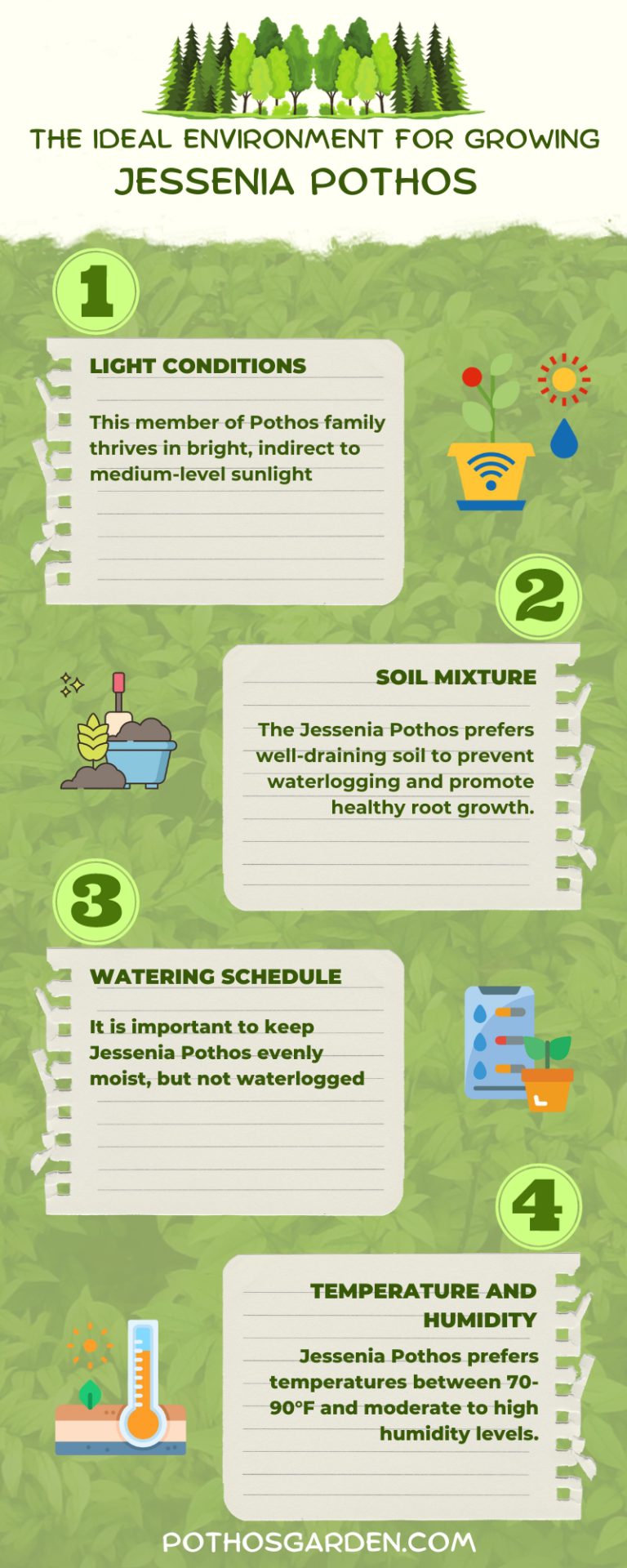
Light Conditions
This member of Pothos family thrives in bright, indirect to medium-level sunlight. However, direct sun exposure should be avoided as it can harm the foliage and cause scorching.
Soil Mixture
The Jessenia Pothos prefers well-draining soil to prevent waterlogging and promote healthy root growth.
Watering Schedule
It is important to keep Jessenia Pothos evenly moist, but not waterlogged. Wait until the top inch of soil is dry before watering . In general, indoor Pothos plants, including Jessenia, typically require watering every three to seven days.
Temperature and Humidity
Jessenia Pothos prefers temperatures between 70- 90°F and moderate to high humidity levels. Maintaining a warm environment with temperatures ideally ranging from 65°F to 80°F is recommended, while avoiding temperatures below 55°F.
Regular misting or using a humidifier can help maintain adequate humidity levels, while keeping the plant away from vents or drafty windows.
Nourishing Your Jessenia Pothos
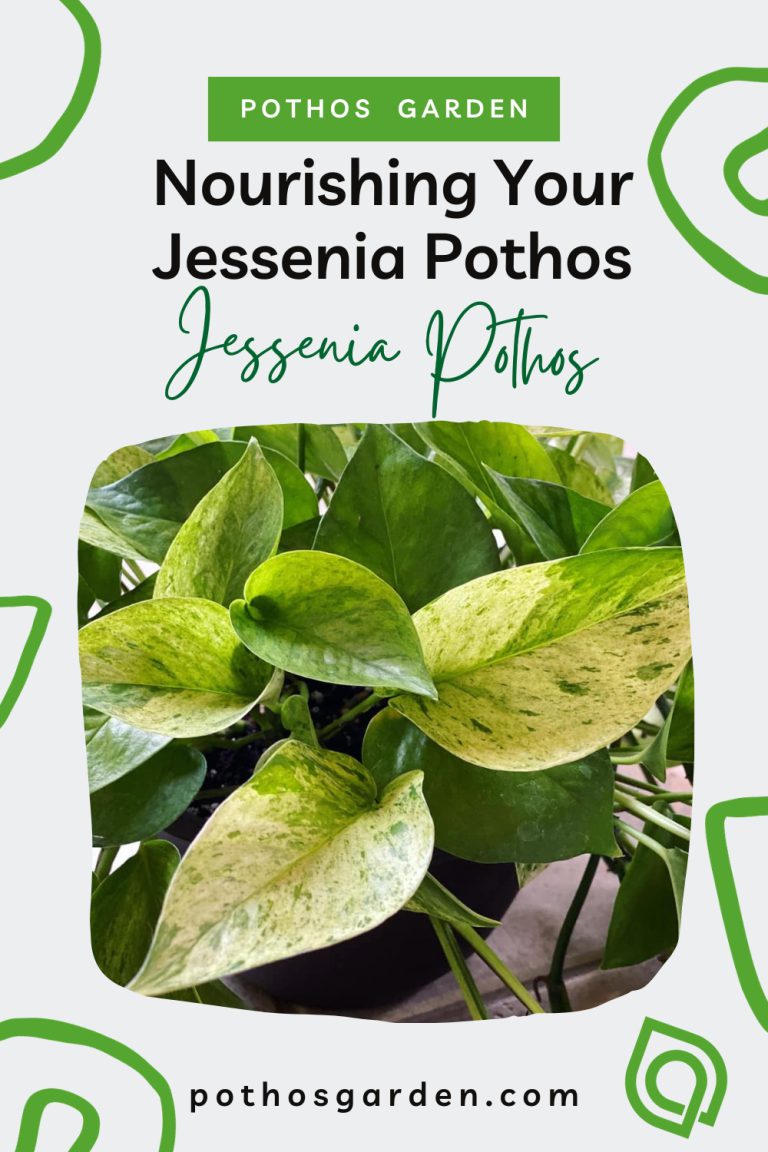
Fertilization
To ensure optimal growth, Jessenia Pothos benefits from regular fertilization during its active growing period. Applying a balanced liquid fertilizer once a month throughout the growing season is recommended.
In Spring and Summer, fertilize every 6-8 weeks to provide essential nutrients. However, it’s important to refrain from fertilizing during autumn and winter, as the plant enters a period of dormancy.
Pruning
Pruning isn’t just for aesthetics; it’s also essential for the health of your Jessenia Pothos. Removing dead or yellow leaves and cutting back any overgrown vines will encourage more robust and healthier growth.
Propagation
It can be easily propagated through stem cuttings, whether in water or soil. This method allows you to expand your plant collection and share the beauty of Jessenia with others. the best time to pick the cutting is in spring and summer.
Potting and Repotting
When your Jessenia Pothos outgrows its pot, it’s time for a new home. Choose a pot that’s 1-2 inches larger in diameter than the current one and make sure it has good drainage.
Common Problems and Troubleshooting Tips:
Yellow Leaves
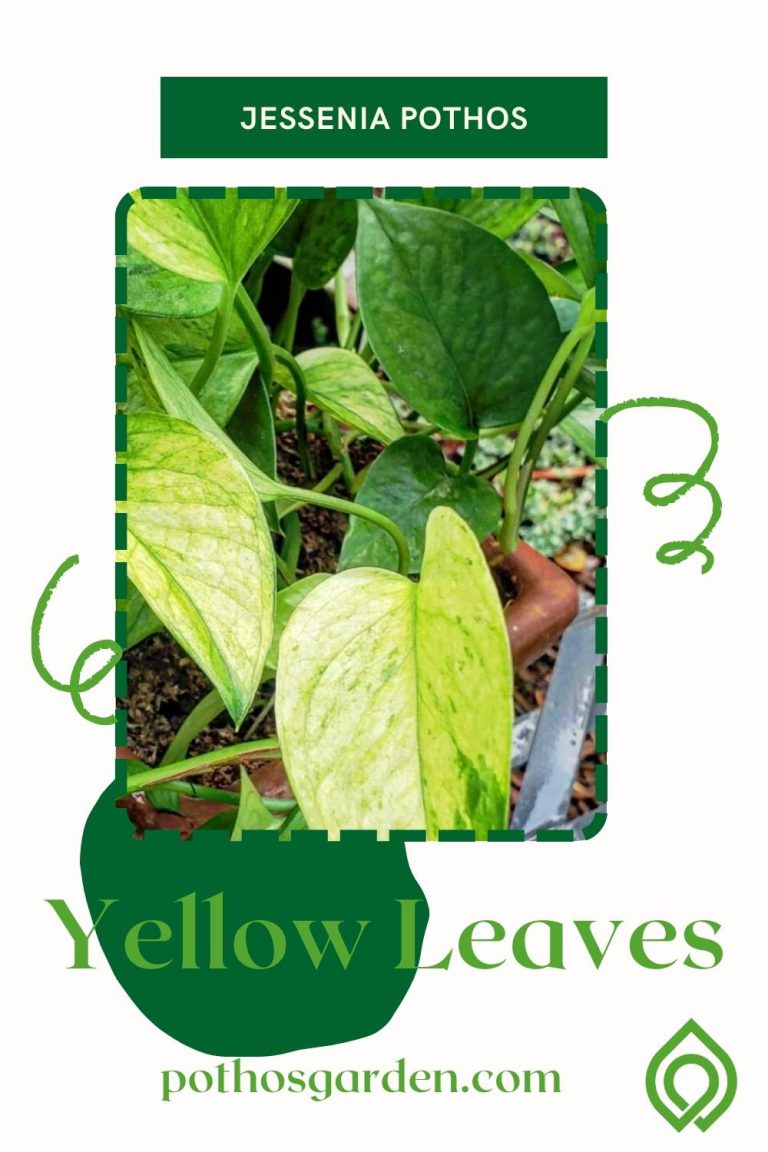
If you notice yellowing leaves, it might be a sign of overwatering, underwatering, or excessive fertilizer use. Adjust your watering schedule and fertilizer application to find the right balance for your plant’s needs.
Brown Leaves
Brown leaves can indicate too much direct sunlight or low humidity levels. Relocate your plant to a spot with indirect light or increase humidity around it by misting the leaves or using a humidifier.
Stunted Growth
Slow or stunted growth may be a result of inadequate light or nutrient deficiency. Move your plant to a brighter location and ensure regular fertilization to provide the necessary nutrients for healthy growth.
Root Rot
Overwatering or poor drainage can lead to root rot. Ensure that the soil is well-draining and allow the top inch of soil to dry out before watering again to prevent this issue.
Pests
This variety of Pothos can be also susceptible to pests such as spider mites and mealybugs. Use insecticidal soap or neem oil to eliminate these pests and protect the health of your plant.
Loss of Variegation
Insufficient light can cause a loss of variegation in the leaves. Place your plant in a brighter location to encourage vibrant variegation patterns.
Bacterial Wilt Disease
Bacterial wilt disease can cause wilting and death of the plant. If affected, remove the affected parts and consider transplanting your Jessenia Pothos into a new pot to prevent further spread.
Why Should You Read This Article?
If you’re a plant enthusiast or looking to enhance your indoor garden with a unique and rare variety, Jessenia Pothos (Epipremnum aureum ‘Jessenia’) is a captivating plant that deserves your attention.
This article provides valuable insights into the distinct features of Jessenia Pothos, including its striking variegation, ability to thrive in low light, air-purifying properties, easy care requirements, and its aesthetic appeal. You’ll also find comparisons with other Pothos varieties, tips for care and maintenance, and troubleshooting advice for common problems.

